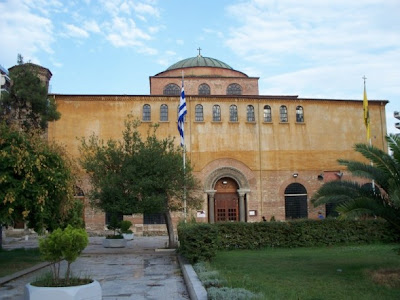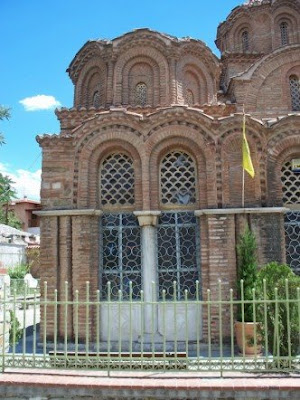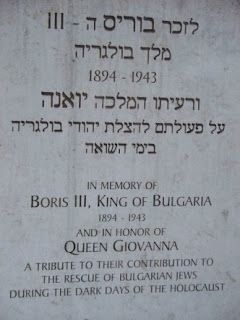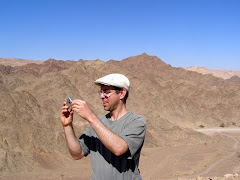 e to my love of theater. When I visited London years ago, I went to three musicals--including Les Miserables. Between that visit and this, I heard that a replica of the Globe theater had been built and have long wanted to see a play there. During this visit, I managed to make it to three. In between, I went on the tour and spent time reading the exhibits about the original Globe theater.
e to my love of theater. When I visited London years ago, I went to three musicals--including Les Miserables. Between that visit and this, I heard that a replica of the Globe theater had been built and have long wanted to see a play there. During this visit, I managed to make it to three. In between, I went on the tour and spent time reading the exhibits about the original Globe theater.As a Shakespeare enthusiast, it was satisfying to learn something about the setting of most of Shakespeare's plays. First, why the theater was where it was: The original Globe was located across the river from the city which made it easier for the company to operate at a time when the Puritans were adamently against theater and the local authorities in London succumbed to the pressure and, inconsistently, applied restrictions. I'm not very clear about theater-politics in those days (royalty sponsored plays and Elizabeth was a Shakespeare fan too) but it being across the river next to the bars and brothels was a strategy to allow the play to go on. How the theater go there in the first place is also interesting. The business guy had a theater on the London side of the river on rented land and when the lease was over, he technically had the right to the building but, in practice, the building would come under the control of the land owner. So one night when the river was frozen over and the land owner was out of town, the theater business guy and some buddies took the building apart and moved it across the river and rebuilt it as the Globe--safe from the increasingly restrictive anti-theater regulations.
The second thing I learned about Shakespeare plays by having visited the Globe was pointed out during the tour of the place. It involves the ambitiousness of Elizabethan theater. A commentary I read soon afterwards explains it well:
Elizabethan theater ... [involves] a complex playing area, with a
central platform, an alcove or discovery space at the rear, flanked by doors, a trap door leading to a cellarage below, a balcony or balustraded space above, with possibly a second level above that,
and on the platform itself a pari of great columns that divide the stage. We have a versatile, multiple playing space which can represent locales such as a field, a castle, a city wall, a ship's deck, a forest, a
desert, a cave, a cell, a tavern, a hall of state, or a street, in free
alternation or succession. Characters can wander in from one
door and out another, lean out of windows or emerge from the alcove, skulk behind pillars or peer from over arrases, and they may occupy two or more parts of the stage simultaneously. ... [Such as] in historical plays, when besieging armies stationed on the platform challenge the defenders of a town or castle situated above ... other theaters aim at compression and selectivity, at making a little stand for a lot. The Elizabethans wish to drag the whole lot bodily onto the stage. The other theaters hedge themselves about with exclusions and taboos. The really exciting actions, the violence, the sensationalism, the amorous encounters, the magical occurrences, all happen, as Victor Hugo complained, frustratingly offstage. Only the Elizabethans, with
their split-level stage, theirm dumb shows, gods, and ghosts,
their gluttony for spectacular effects, try to make everying at once
visible, audible, and palpable" (Jonas A. Barish, "Multiple Scenes,
Characters, and Plots in Elizabethan Drama" 61-64 in Elizabethan Drama, Laura K Egendorf, editor).
The tour guide also pointed out that the Globe theater was destroyed by fire during a performance of Henry VIII. The company decided that they had to pull out all the stops to depict the founder of the Tudor dynasty and Elizabeth's father so they used a real cannon--the firing of which lit the thatched roof on fire and that was the end of the original Globe. I guess a case can be made for keeping it simple.
One of the interesting options for theater-goers in the Elizabethan era was to pay a minimal admission and stand up through the performance--to be a "groundling." This tradition was
 resurrected with the reconstruction of the edifice. When I heard about the modern version of groundlings, I had heard that they, like their Elizabethan era counterparts, yelled at the actors and that the actors responded to them but, unfortunately, the groundlings I witnessed were much more well behaved. I liked the idea of saving a substantial number of pounds for each ticket but figured that my hosts (who let me stay with them a bit outside London) deserved seats. I also wanted to save my legs for walking around town and rather than for standing for a few three hour Shakespeare plays. On my last day in the city I decided to go back for another Shakespeare play and would have done the "groundling" thing but none were available so I sat again.
resurrected with the reconstruction of the edifice. When I heard about the modern version of groundlings, I had heard that they, like their Elizabethan era counterparts, yelled at the actors and that the actors responded to them but, unfortunately, the groundlings I witnessed were much more well behaved. I liked the idea of saving a substantial number of pounds for each ticket but figured that my hosts (who let me stay with them a bit outside London) deserved seats. I also wanted to save my legs for walking around town and rather than for standing for a few three hour Shakespeare plays. On my last day in the city I decided to go back for another Shakespeare play and would have done the "groundling" thing but none were available so I sat again.If I make it back to London, I'll probably trade the ideal setting for the best acting and try to catch a play by the Royal Shakespeare Company. I'd also like to make the ultimate Shakespearean pilgrimage to Shakespeare's home neighborhood at Stratford upon Avon.


















































